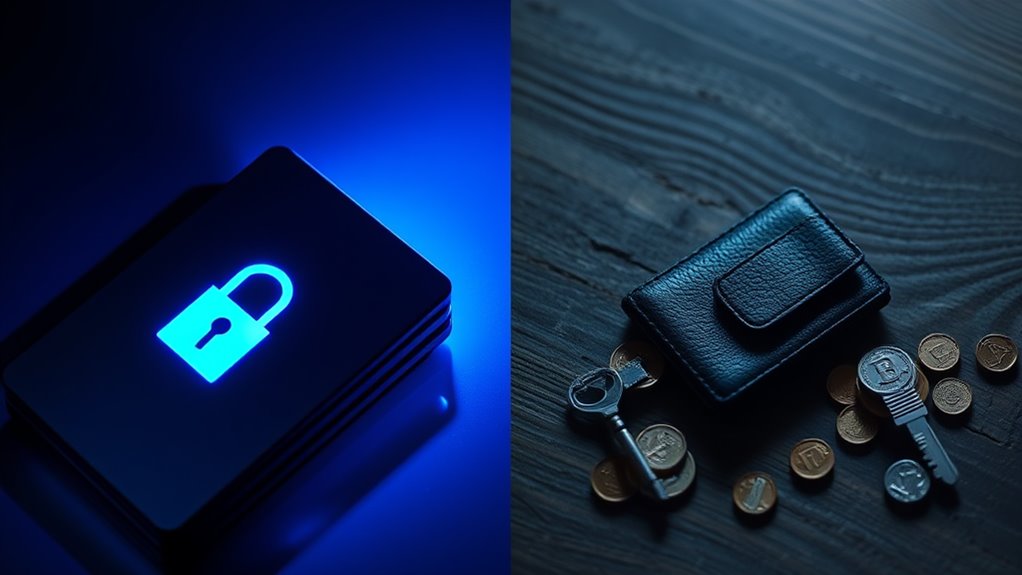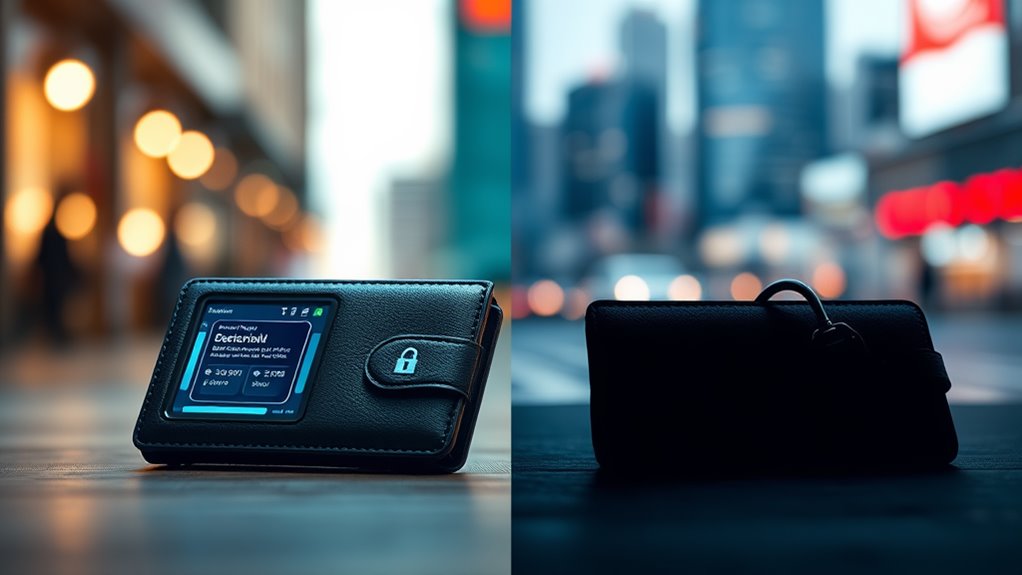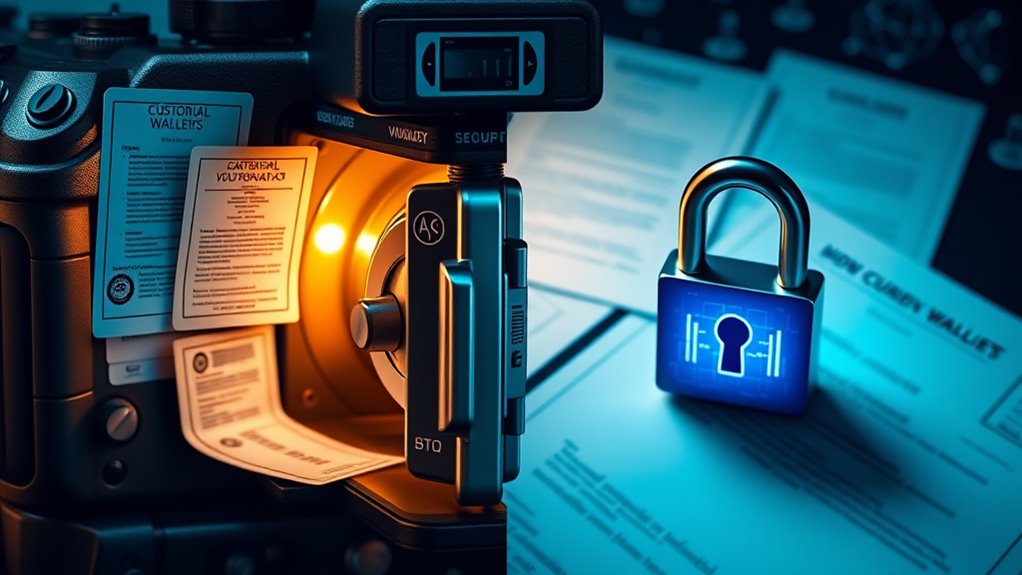
Custodial Vs Non-Custodial Wallets: Which Offers Better Security?
Custodial wallets provide security through third-party management, simplifying user access but requiring trust in the provider’s protection measures. They can be targets for hackers, leading to potential risks like data breaches. Conversely, non-custodial wallets grant users full control over their private keys, enhancing privacy and reducing centralized risks. However, users must manage their own security. Each type has specific advantages and challenges, making it essential to assess individual needs before choosing the right wallet option. More insights follow.
Key Takeaways
- Non-custodial wallets provide greater asset control and privacy, reducing exposure to centralized breaches compared to custodial wallets.
- Custodial wallets are attractive targets for hackers due to their centralized nature, increasing the risk of hacking and data breaches.
- Users of non-custodial wallets must implement their own key management, which can enhance security but requires vigilance to avoid losing access.
- Custodial wallets offer user-friendly recovery options, but they rely on the provider’s security measures, which may not be foolproof.
- Hybrid wallets can combine security features from both types, potentially providing enhanced protection while maintaining some level of user control.
Understanding Custodial Wallets

Custodial wallets represent a significant aspect of cryptocurrency management, functioning as tools that facilitate the storage and handling of digital assets.
These wallets are managed by third-party providers, such as cryptocurrency exchanges or financial institutions, which hold users’ private keys. This arrangement allows users to access and manage their funds in a centralized platform, similar to traditional banking systems.
Custodial wallets are managed by third-party providers, offering centralized access to funds akin to traditional banking systems.
While custodial wallets offer convenience, particularly for beginners, users do not have direct control over their private keys, which are managed by the custodian.
Many custodial services comply with regulations like Know Your Customer (KYC) and Anti-Money Laundering (AML) requirements, enhancing trust.
Additionally, custodial wallets often include features such as account recovery and integrated services, making them a popular choice for many users. Moreover, custodial wallets provide a centralized platform for users to interact with their digital assets efficiently.
Exploring Non-Custodial Wallets

Non-custodial wallets provide users with the ability to manage their own private keys and cryptocurrency funds, empowering individuals with greater control over their digital assets.
These wallets can be accessed through browser extensions, mobile apps, or hardware devices, with hardware wallets being the most secure option due to their offline operation.
Users bear the responsibility of safeguarding their private keys and recovery phrases, as losing this information can lead to the permanent loss of access to funds.
Non-custodial wallets also enhance privacy, as there is no centralized authority managing user data.
However, they require users to possess some technical knowledge, making transaction management more complex compared to custodial options, underscoring the importance of careful handling and backups. Additionally, these wallets enable users to engage with decentralized applications (dApps), further enhancing their experience in the DeFi ecosystem.
Security Models: Custodial Vs Non-Custodial

When comparing security models between custodial and non-custodial wallets, key management differences play an essential role in user safety.
Custodial wallets rely on third-party services for security, which can introduce vulnerabilities such as data breaches and phishing attacks, while non-custodial wallets empower users to manage their private keys, increasing their control but also their responsibility. Implementing strong, unique passwords and enabling two-factor authentication is crucial for enhancing security in both wallet types.
Understanding these distinctions is vital for users to assess their own risk tolerance and security needs in the evolving landscape of digital finance.
Key Management Differences
The management of private keys is a critical aspect of cryptocurrency wallets, influencing both security and user experience.
Custodial wallets, where third-party services manage private keys, offer convenience but require users to trust the provider’s security measures. In contrast, non-custodial wallets allow users full control over their keys, enhancing privacy but placing the burden of security entirely on them.
- Custodial wallets prioritize ease of use with password recovery options.
- Non-custodial wallets offer greater asset control and privacy.
- Users of custodial wallets rely on the provider for security.
- Non-custodial wallet users must implement their own key management practices.
Understanding these key management differences helps users make informed choices about their cryptocurrency storage options. Additionally, many users opt for a combination of both wallet types to balance convenience and security.
Security Vulnerabilities Comparison
Security vulnerabilities in cryptocurrency wallets can greatly affect users’ financial safety and overall experience.
Custodial wallets are centralized, making them attractive targets for hackers, as illustrated by historical breaches like Mt. Gox and QuadrigaCX. These incidents highlight the risks associated with reliance on a provider, whose security measures may fail. Users also face threats like identity theft and social engineering attacks, as custodial wallets require personal information.
In contrast, non-custodial wallets grant users control over private keys, reducing the risk of centralized breaches. However, they come with the responsibility of securely managing those keys. Maintaining a secure internet connection is vital in minimizing risks when using non-custodial wallets.
User Control Levels
User control levels in cryptocurrency wallets greatly differ between custodial and non-custodial models, impacting how users interact with their funds.
- Custodial Wallets: Users do not control their private keys, requiring authorization to access funds.
- Non-Custodial Wallets: Users maintain full control over their private keys, allowing direct access to their funds.
- Privacy Considerations: Custodial wallets generally require identity verification, reducing user anonymity, while non-custodial wallets offer higher privacy levels by avoiding personal data collection.
- Technical Responsibility: Non-custodial users must manage their keys securely, which necessitates a certain level of technical knowledge, unlike custodial wallets that provide integrated support services.
These differences highlight varying degrees of user autonomy and security in managing cryptocurrency assets. Additionally, users should consider the security model of their chosen wallet type, as it plays a crucial role in protecting their investments.
Key Management and User Control

Key management and user control are essential aspects of cryptocurrency wallets, largely influencing how individuals interact with their digital assets.
In custodial wallets, third parties manage private keys, which limits user control and increases reliance on these entities for security. This centralized approach exposes users to higher risks of hacks and data breaches.
Conversely, non-custodial wallets empower users to manage their own private keys, offering greater security and full ownership of assets. They allow offline access, greatly reducing the risk of online threats. However, this increased responsibility also means that users must safeguard their keys diligently, as losing them can result in permanent loss of access to their funds. Regularly updating security software is crucial for all users to maintain their digital security.
Non-custodial wallets provide users with full control over their private keys, enhancing security and minimizing online risks.
Understanding these differences is vital for informed wallet selection.
Recovery Processes and Accessibility

Recovery processes and accessibility are significant considerations when choosing between custodial and non-custodial wallets.
Custodial wallets offer more straightforward recovery methods, often supported by third-party services that assist users in regaining access to their funds. In contrast, non-custodial wallets require users to securely manage their seed phrases, with loss leading to permanent inaccessibility of funds.
- Custodial wallets provide customer support for recovery.
- Non-custodial wallets depend entirely on user responsibility for access.
- User-friendly interfaces in custodial wallets enhance accessibility for beginners.
- Non-custodial wallets allow offline access, improving security for advanced users.
Additionally, custodial wallets typically manage user security through strong security measures, such as unique passwords and two-factor authentication.
Ultimately, the choice between these wallet types hinges on users’ preferences for convenience versus control over their assets.
Risks Associated With Custodial Wallets

Custodial wallets present several risks that users should carefully consider before opting for this type of storage for their digital assets.
One major risk is hacking vulnerabilities, as centralized systems are attractive targets for cybercriminals. Users also face potential data breaches, which can expose personal and financial information.
Additionally, custodial wallets can be susceptible to phishing attacks and social engineering tactics targeting employees of the wallet provider. Financial instability or mismanagement of the custodian can jeopardize users’ access to funds.
Furthermore, regulatory changes and legal issues may affect the availability of services. Finally, users often lack control over their assets and personal data, raising concerns about privacy and surveillance.
Understanding these risks is essential for informed decision-making. Moreover, the lack of multisig wallets in custodial services can amplify the risk of single-point failures in securing users’ assets.
Advantages of Non-Custodial Wallets

Non-custodial wallets offer several advantages that make them appealing to users seeking control over their digital assets. These wallets empower users by placing the management of their funds directly in their hands, ensuring greater security and privacy.
- Full Access to Funds: Users maintain complete control over their digital assets without third-party interference.
- Private Key Management: Users are responsible for managing their private keys, enhancing security.
- No Counterparty Risk: Assets are not vulnerable to the risks associated with custodial services.
- Security Through Independence: The absence of a central server minimizes hacking risks and data breaches.
Additionally, non-custodial wallets can provide enhanced security through secure offline storage, safeguarding private keys from online threats.
These features collectively enhance user autonomy, making non-custodial wallets a favorable option for those prioritizing security and privacy in the management of their cryptocurrencies.
User Experience and Interface Comparison

When comparing user experience in custodial and non-custodial wallets, ease of navigation and technical complexity emerge as key factors.
Custodial wallets typically feature user-friendly interfaces that simplify the management of cryptocurrencies, making them accessible for beginners.
In contrast, non-custodial wallets often involve more complex processes, requiring users to have a deeper understanding of private key management and security protocols, which can be challenging for those less experienced in cryptocurrency.
Ease of Navigation
Maneuvering the world of cryptocurrency wallets involves understanding the differences in user experience and interface between custodial and non-custodial options.
- Custodial wallets feature user-friendly interfaces, designed for beginners with simple dashboards.
- Non-custodial wallets often require technical knowledge, presenting complex interfaces that may confuse new users.
A significant number of users, about 72%, prefer non-custodial wallets for enhanced security but report usability challenges.
Custodial wallet providers offer extensive support, aiding users with account recovery and management, which can ease navigation.
Technical Complexity
Understanding the technical complexity of cryptocurrency wallets reveals significant differences between custodial and non-custodial options. Custodial wallets simplify user experience by managing private keys and seed phrases internally, making them more accessible for those without extensive technical knowledge. In contrast, non-custodial wallets require users to handle their keys and backups, demanding a higher level of understanding and responsibility.
| Feature | Custodial Wallets |
|---|---|
| Key Management | Managed by service |
| User Control | Limited control |
| Technical Understanding Needed | Low |
| Backup Responsibility | Handled by service |
| Recovery Options | Often available |
This contrast highlights how custodial wallets cater to beginners, while non-custodial options appeal to users seeking greater autonomy.
Regulatory Compliance and Legal Considerations

Regulatory compliance and legal considerations play an essential role in the landscape of custodial and non-custodial wallets, particularly as the cryptocurrency market continues to evolve.
Custodial wallets face stricter regulations due to their role in managing user assets. This includes requirements such as:
Custodial wallets are subject to stringent regulations, reflecting their responsibility in managing user assets effectively.
- Licensing and Authorization: Necessitating specific licenses, like a money transmitter license in the U.S.
- KYC/AML Policies: Implementing Know Your Customer and Anti-Money Laundering measures for compliance.
- Reporting Obligations: Often required to report transactions to regulatory bodies.
- Counterparty Risk: Introduces reliance on a third party for asset security and management.
In contrast, non-custodial wallets generally encounter fewer legal restrictions, offering users greater control over their assets.
Choosing the Right Wallet for Your Needs

When choosing a wallet, users must weigh their preferences for user experience against their security needs.
Custodial wallets offer convenience and ease of use, making them appealing for beginners, but they come with certain security risks.
On the other hand, non-custodial wallets provide greater control and security, yet they require users to take full responsibility for managing their private keys.
User Experience Considerations
How does one choose the right wallet to suit their cryptocurrency needs? User experience plays a significant role in this decision.
Beginners may find custodial wallets more appealing due to their user-friendly interfaces, while non-custodial wallets may require more technical knowledge. Key considerations include:
- Ease of Use: Custodial wallets offer minimal learning curves.
- Customer Support: Better support options can ease problem resolution for custodial wallets.
- Integration: Custodial wallets often provide additional services like trading, enhancing user experience.
- Accessibility: Non-custodial wallets allow offline use, which may benefit security-conscious users.
Ultimately, understanding personal preferences and technical abilities can guide users toward the wallet best suited for their cryptocurrency journey.
Security vs. Convenience Balance
Choosing the right cryptocurrency wallet involves balancing security and convenience, as each type offers distinct advantages and drawbacks.
Custodial wallets provide ease of use, allowing direct transactions and customer support, but they pose risks due to centralized management, making them targets for hackers.
In contrast, non-custodial wallets grant users full control over their assets and private keys, enhancing security through offline storage and encryption. However, they require users to proactively manage their keys, which can lead to potential loss if mishandled.
Some users may prefer hybrid models that offer a blend of both security and convenience.
Ultimately, individuals should assess their priorities to determine the most suitable wallet type for their needs.
Frequently Asked Questions
Can Custodial Wallets Be Hacked Despite Security Measures?
Custodial wallets can indeed be hacked despite security measures. Their reliance on third-party management exposes them to risks, including significant breaches, demonstrating that advanced security does not guarantee immunity from cyber threats and attacks.
Are Non-Custodial Wallets Suitable for Beginners?
In an age where digital autonomy reigns supreme, non-custodial wallets present both opportunity and challenge for beginners. While they offer enhanced security and control, the complexities of key management may overwhelm those lacking technical knowledge.
How Can I Recover Lost Access to a Non-Custodial Wallet?
Recovering lost access to a non-custodial wallet typically involves utilizing seed phrases, checking old devices, or employing professional recovery services. Alternatives like social recovery and data recovery tools may also assist, albeit with varying success rates.
Do Custodial Wallets Support Multiple Cryptocurrencies?
Custodial wallets indeed support multiple cryptocurrencies, allowing users to manage various assets conveniently. This feature simplifies portfolio management, enabling easy transactions and exchanges within the same platform, catering to diverse digital asset holders efficiently.
What Happens if a Custodial Wallet Provider Shuts Down?
If a custodial wallet provider shuts down, users may lose access to their assets, as seen in the hypothetical case of a sudden closure affecting thousands, trapping funds and limiting recovery options for users.
Conclusion
In conclusion, the choice between custodial and non-custodial wallets hinges on individual preferences and security needs. Custodial wallets offer convenience but at the cost of reduced user control, while non-custodial wallets prioritize security and autonomy. Coincidentally, as users seek more independence, the popularity of non-custodial options continues to grow. Ultimately, understanding the strengths and weaknesses of each type guarantees that users can make informed decisions tailored to their unique circumstances and risk tolerance.












